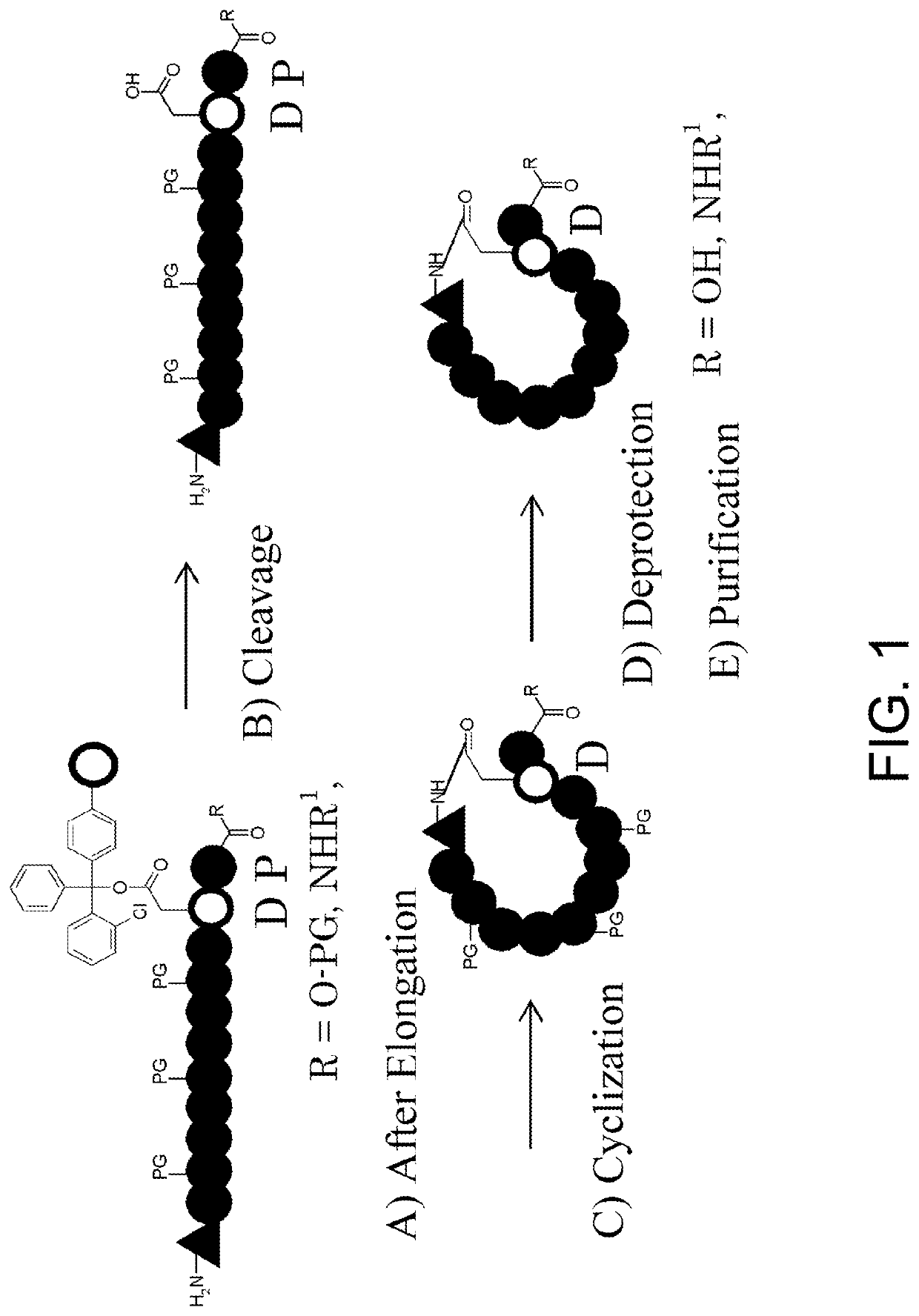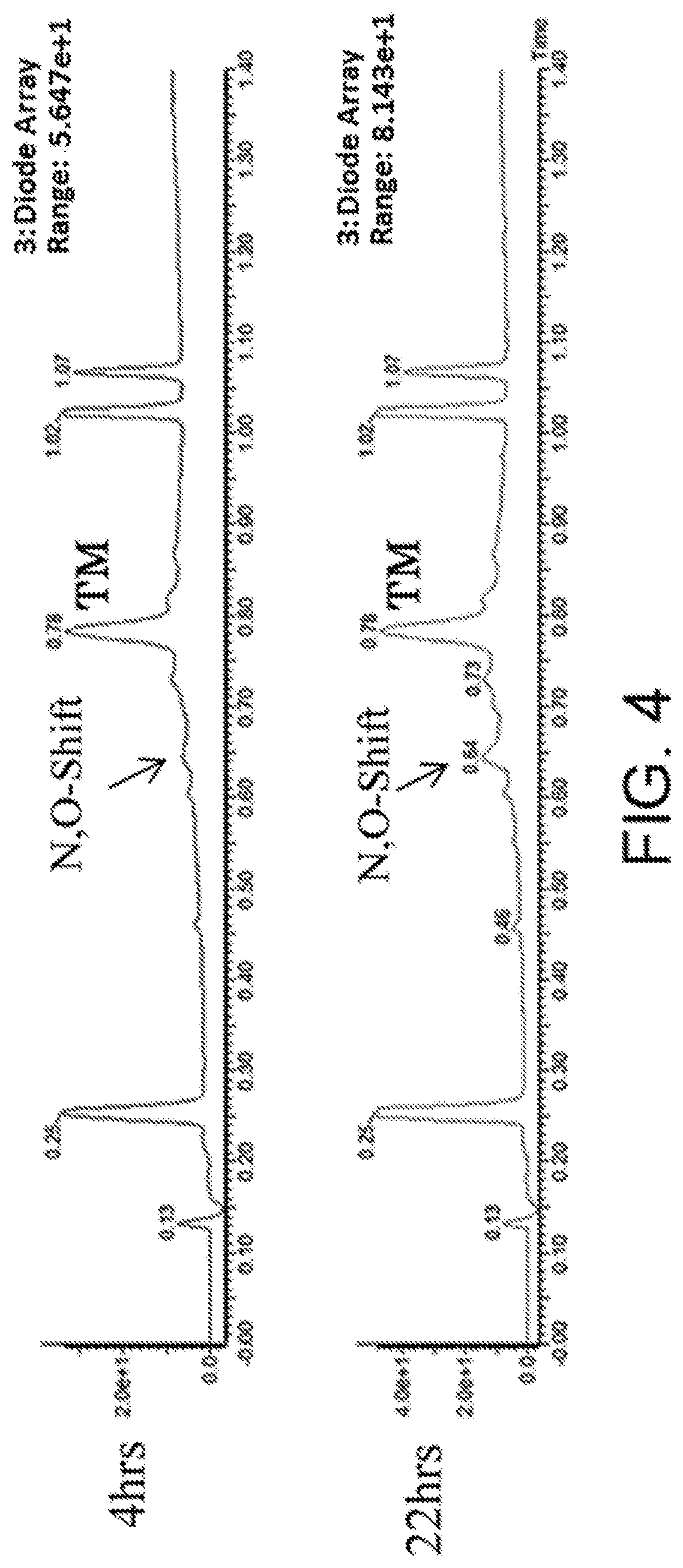Method for synthesizing peptide containing n-substituted amino acid
a technology of amino acid and peptide, which is applied in the field of synthesizing peptides, can solve the problems of insufficient improvement, low elongation efficiency, and extremely slow or unprocedural deprotection reaction on the side chains, and achieve high synthesis efficiency, high purity, and the effect of improving reaction rate and reaction efficiency
- Summary
- Abstract
- Description
- Claims
- Application Information
AI Technical Summary
Benefits of technology
Problems solved by technology
Method used
Image
Examples
example 1
Basic Synthetic Route for Cyclic Peptides Comprising N-Methyl Amino Acids in their Sequences
[0291]Solid-phase synthesis by the Fmoc method was employed for synthesizing cyclic peptides comprising N-methyl amino acids in their sequences, and the synthesis was performed by the synthetic route described in FIG. 1, which involves the following five-steps:[0292]A) elongating the peptide from the N terminus of Asp supported onto a 2-chlorotrityl resin through its side-chain carboxylic acid, by an Fmoc method using a peptide synthesizer;[0293]B) cleaving the peptide off from the 2-chlorotrityl resin;[0294]C) cyclizing the cleaved peptide by amide bonding through condensation of the side-chain carboxylic acid of Asp (open circular unit) and the amino group at the N terminus of the peptide chain (triangular unit);[0295]D) deprotecting the protecting groups of side-chain functional groups included in the peptide chain; and[0296]E) purifying the compound by fractionation HPLC.
[0297]In the Exam...
example 1-1
Synthesis of (2S)-2-((((9H-fluoren-9-yl)methoxy)carbonyl)amino)-3-((tetrahydro-2H-pyran-2-yl)oxy)propanoic acid (Compound 1, Fmoc-Ser(THP)-OH)
[0302]
[0303]Toluene (10 mL) was added to a mixture of (2S)-2-((((9H-fluoren-9-yl)methoxy)carbonyl)amino)-3-hydroxypropanoic acid (Fmoc-Ser-OH; purchased from Watanabe Chemical Industries; 1.0 g, 3.06 mmol) and pyridinium p-toluenesulfonate (PPTS; 0.038 g, 0.153 mmol), and the moisture included was removed by azeotropically distilling off toluene under reduced pressure. Super-dehydrated tetrahydrofuran (THF, 6.1 mL) and 3,4-dihydro-2H-pyran (1.9 mL, 21.3 mmol) were added to the obtained residue, and this was stirred under nitrogen atmosphere at 50° C. for four hours. After confirming disappearance of the raw materials by LCMS (SQDFA05), the mixture was cooled to 25° C., and ethyl acetate (6 mL) was added. Next, saturated aqueous sodium chloride solution (6 mL) was added to wash the organic layer, and the aqueous layer was extracted using ethyl ...
example 1-2
Synthesis of (2S,3R)-2-((((9H-fluoren-9-yl)methoxy)carbonyl)amino)-3-((tetrahydro-2H-pyran-2-yl)oxy)butanoic acid (Compound 2, Fmoc-Thr(THP)-OH)
[0309]
[0310]Toluene (50 mL) was added to a mixture of (2S,3R)-2-((((9H-fluoren-9-yl)methoxy)carbonyl)amino)-3-hydroxybutanoic acid monohydrate (monohydrate of Fmoc-Thr-OH; purchased from Tokyo Chemical Industry; 5.0 g, 13.9 mmol) and pyridinium p-toluenesulfonate (PPTS; 0.175 g, 0.70 mmol), and the moisture included was removed by azeotropically distilling off toluene under reduced pressure. Super-dehydrated tetrahydrofuran (THF, 28 mL) and 3,4-dihydro-2H-pyran (8.8 mL, 97 mmol) were added to the obtained residue, and this was stirred under nitrogen atmosphere at 50° C. for four hours. After confirming disappearance of the raw materials by LCMS (SQDFA05), the mixture was cooled to 25° C., and ethyl acetate (30 mL) was added. Next, saturated aqueous sodium chloride solution (30 mL) was added to wash the organic layer, and the aqueous layer wa...
PUM
| Property | Measurement | Unit |
|---|---|---|
| pKa | aaaaa | aaaaa |
| pH | aaaaa | aaaaa |
| pH | aaaaa | aaaaa |
Abstract
Description
Claims
Application Information
 Login to View More
Login to View More - R&D
- Intellectual Property
- Life Sciences
- Materials
- Tech Scout
- Unparalleled Data Quality
- Higher Quality Content
- 60% Fewer Hallucinations
Browse by: Latest US Patents, China's latest patents, Technical Efficacy Thesaurus, Application Domain, Technology Topic, Popular Technical Reports.
© 2025 PatSnap. All rights reserved.Legal|Privacy policy|Modern Slavery Act Transparency Statement|Sitemap|About US| Contact US: help@patsnap.com



